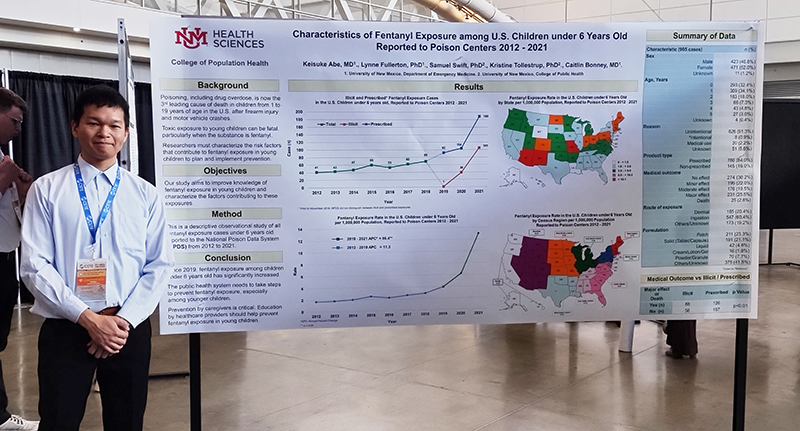“Why and how does a baby get fentanyl?”
This is what entered the mind of Keisuke “KK” Abe, MD, MPH on his second day of practice working in the pediatric emergency department at The University of New Mexico Hospital in 2021 when he saw young children being rushed in for treatment from the life-threatening drug. Abe felt a calling to address this issue, so he enrolled into the Master of Public Health (MPH) program with a concentration in Epidemiology at the College of Population Health (COPH) during his Pediatric Emergency Medicine fellowship.
Fentanyl is a pain-relieving drug that has become a household name as the effects of overdose continue to cause devastation all over the country. People of all ages and backgrounds are not immune to the dangerous outcomes, but it is the risk posed to babies that inspired Abe’s passion to pursue further research and education in public health with UNM.

Fast forward to 2024, Abe is now among experts in his field. He recently presented his research at the 2024 Council of State and Territorial Epidemiologists (CSTE) Annual Epidemiology Conference in Pittsburgh. The conference brings together professionals from around the world to discuss public health and epidemiology. Abe’s presentation titled "Characteristics of Fentanyl Exposure in Infants and Toddlers in the U.S, Reported to Poison Centers, 2012-2021" shared insights about his in-depth research on fentanyl exposure in young children.
His study focused on fentanyl exposure among children under six years old reported between 2012 - 2021. Abe found fentanyl exposure began increasing in 2012 and started to dramatically increase in 2019. Of the 905 cases studied, Abe’s results showed more severe medical outcomes for children from both prescribed and unprescribed sources including 2.8% who died and 45% who experienced moderate to major effects leading to hospitalization. A key finding from the research was that most exposures were unintentional (91.3%), and Abe found prevention, especially by caregivers, to be critical. Fentanyl needs to be safely stored or disposed of to prevent child exposures.
Abe’s work to help young patients is just beginning. After completing his fellowship program and MPH at UNM, Abe plans to relocate to Kansas to continue his work while fulfilling visa requirements by providing medical services to underserved areas. Looking ahead, he hopes to join an academic health center, engage in research, and work closely with pediatric patients and their parents. His goal is to use his MPH and epidemiology background to make meaningful contributions to public health research and practice, particularly in collaboration with state health departments.
As Abe prepares to leave New Mexico, he expresses appreciation for what knowledge he has gained during his time at the UNM College of Population Health. He appreciates the diverse backgrounds and perspectives of his classmates and professors, which enriched his learning experience. Abe gives credit to Samuel Swift, PhD, MPH, for being a mentor and encouraging him to present his findings in a journal as well as at the conference. Abe is also particularly grateful for the kindness and support he received from his peers, which helped him navigate the nuances of American education and public health terminology. He looks forward to continuing his work in epidemiology and making a positive impact on public health in the years to come.
